Brinker International BIBA Case Study
VerifiedAdded on 2023/02/01
|8
|1428
|35
AI Summary
This case study analyzes the Business Intelligence (BI) competency center of Brinker International, Inc. and how it helped the company in various stages of data sourcing, information development, business knowledge creation, and functional wisdom.
Contribute Materials
Your contribution can guide someone’s learning journey. Share your
documents today.
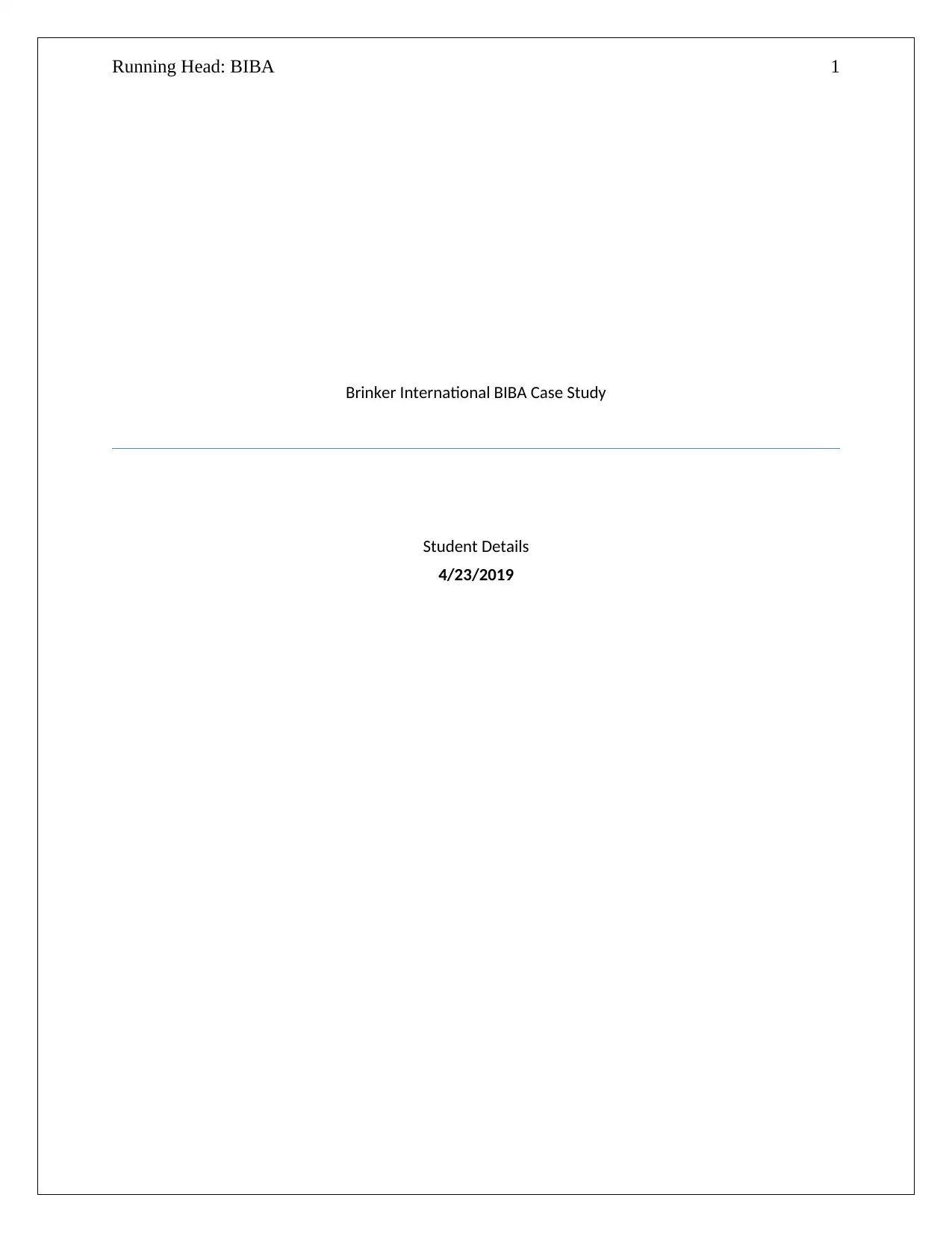
Running Head: BIBA 1
Brinker International BIBA Case Study
Student Details
4/23/2019
Brinker International BIBA Case Study
Student Details
4/23/2019
Secure Best Marks with AI Grader
Need help grading? Try our AI Grader for instant feedback on your assignments.
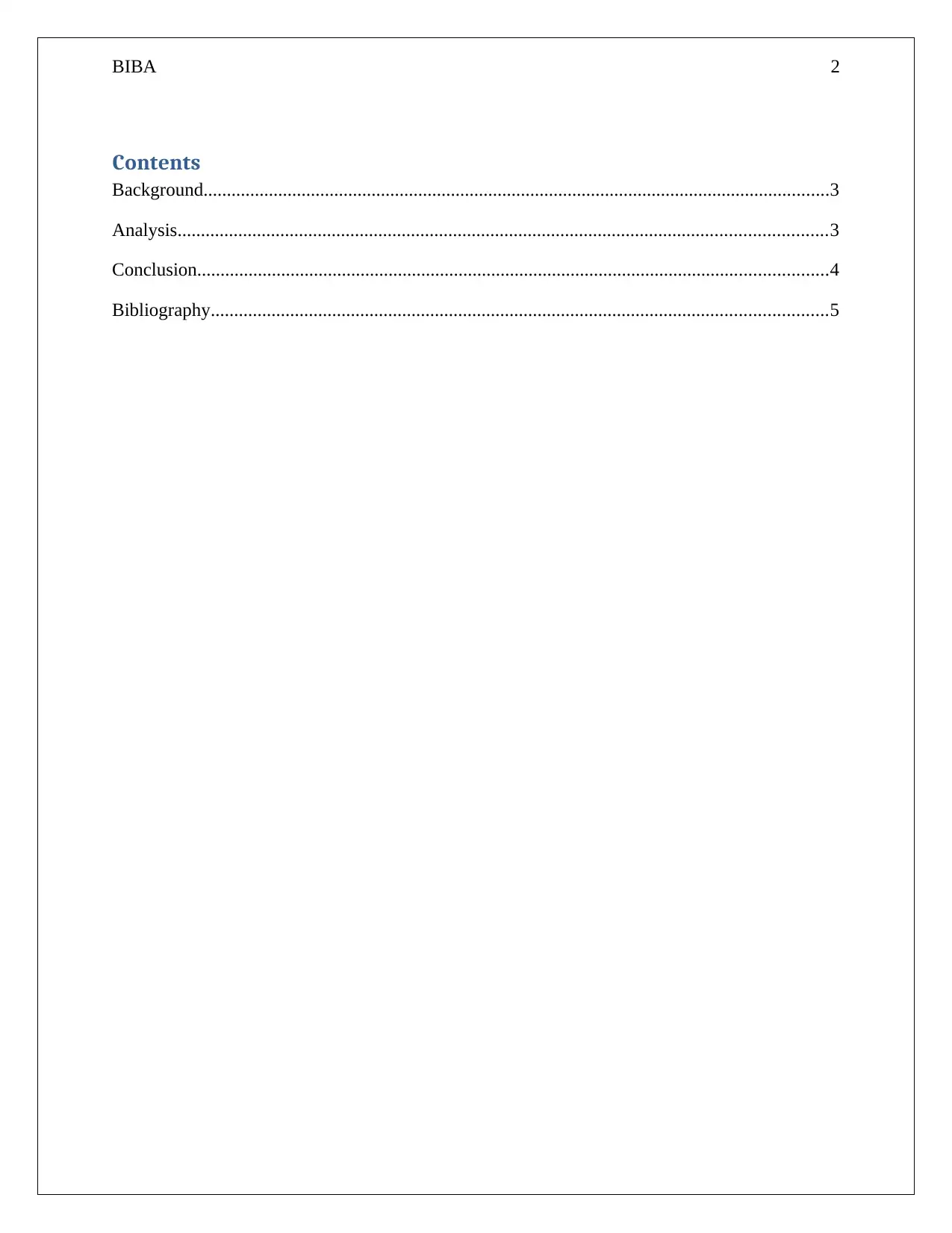
BIBA 2
Contents
Background......................................................................................................................................3
Analysis...........................................................................................................................................3
Conclusion.......................................................................................................................................4
Bibliography....................................................................................................................................5
Contents
Background......................................................................................................................................3
Analysis...........................................................................................................................................3
Conclusion.......................................................................................................................................4
Bibliography....................................................................................................................................5
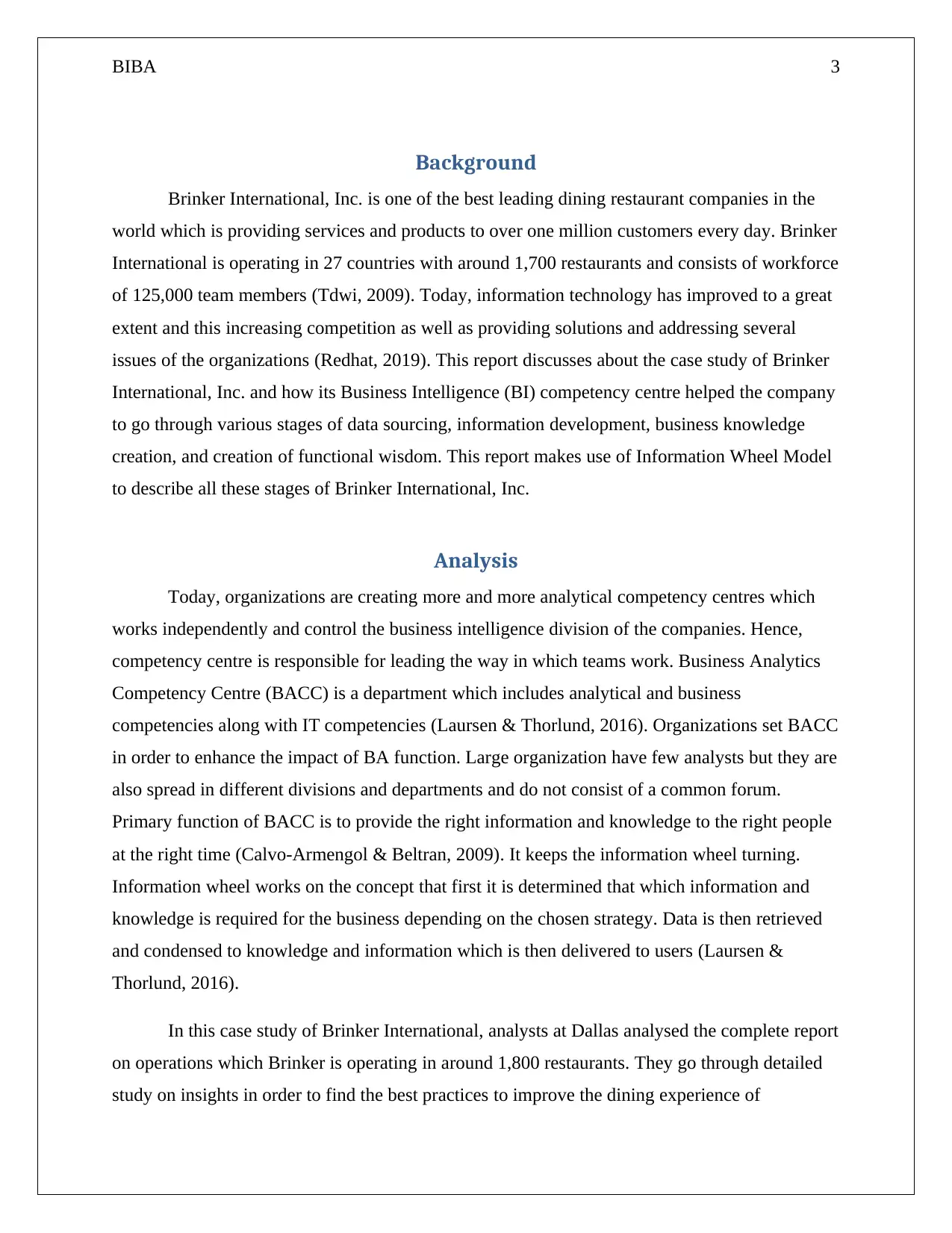
BIBA 3
Background
Brinker International, Inc. is one of the best leading dining restaurant companies in the
world which is providing services and products to over one million customers every day. Brinker
International is operating in 27 countries with around 1,700 restaurants and consists of workforce
of 125,000 team members (Tdwi, 2009). Today, information technology has improved to a great
extent and this increasing competition as well as providing solutions and addressing several
issues of the organizations (Redhat, 2019). This report discusses about the case study of Brinker
International, Inc. and how its Business Intelligence (BI) competency centre helped the company
to go through various stages of data sourcing, information development, business knowledge
creation, and creation of functional wisdom. This report makes use of Information Wheel Model
to describe all these stages of Brinker International, Inc.
Analysis
Today, organizations are creating more and more analytical competency centres which
works independently and control the business intelligence division of the companies. Hence,
competency centre is responsible for leading the way in which teams work. Business Analytics
Competency Centre (BACC) is a department which includes analytical and business
competencies along with IT competencies (Laursen & Thorlund, 2016). Organizations set BACC
in order to enhance the impact of BA function. Large organization have few analysts but they are
also spread in different divisions and departments and do not consist of a common forum.
Primary function of BACC is to provide the right information and knowledge to the right people
at the right time (Calvo-Armengol & Beltran, 2009). It keeps the information wheel turning.
Information wheel works on the concept that first it is determined that which information and
knowledge is required for the business depending on the chosen strategy. Data is then retrieved
and condensed to knowledge and information which is then delivered to users (Laursen &
Thorlund, 2016).
In this case study of Brinker International, analysts at Dallas analysed the complete report
on operations which Brinker is operating in around 1,800 restaurants. They go through detailed
study on insights in order to find the best practices to improve the dining experience of
Background
Brinker International, Inc. is one of the best leading dining restaurant companies in the
world which is providing services and products to over one million customers every day. Brinker
International is operating in 27 countries with around 1,700 restaurants and consists of workforce
of 125,000 team members (Tdwi, 2009). Today, information technology has improved to a great
extent and this increasing competition as well as providing solutions and addressing several
issues of the organizations (Redhat, 2019). This report discusses about the case study of Brinker
International, Inc. and how its Business Intelligence (BI) competency centre helped the company
to go through various stages of data sourcing, information development, business knowledge
creation, and creation of functional wisdom. This report makes use of Information Wheel Model
to describe all these stages of Brinker International, Inc.
Analysis
Today, organizations are creating more and more analytical competency centres which
works independently and control the business intelligence division of the companies. Hence,
competency centre is responsible for leading the way in which teams work. Business Analytics
Competency Centre (BACC) is a department which includes analytical and business
competencies along with IT competencies (Laursen & Thorlund, 2016). Organizations set BACC
in order to enhance the impact of BA function. Large organization have few analysts but they are
also spread in different divisions and departments and do not consist of a common forum.
Primary function of BACC is to provide the right information and knowledge to the right people
at the right time (Calvo-Armengol & Beltran, 2009). It keeps the information wheel turning.
Information wheel works on the concept that first it is determined that which information and
knowledge is required for the business depending on the chosen strategy. Data is then retrieved
and condensed to knowledge and information which is then delivered to users (Laursen &
Thorlund, 2016).
In this case study of Brinker International, analysts at Dallas analysed the complete report
on operations which Brinker is operating in around 1,800 restaurants. They go through detailed
study on insights in order to find the best practices to improve the dining experience of
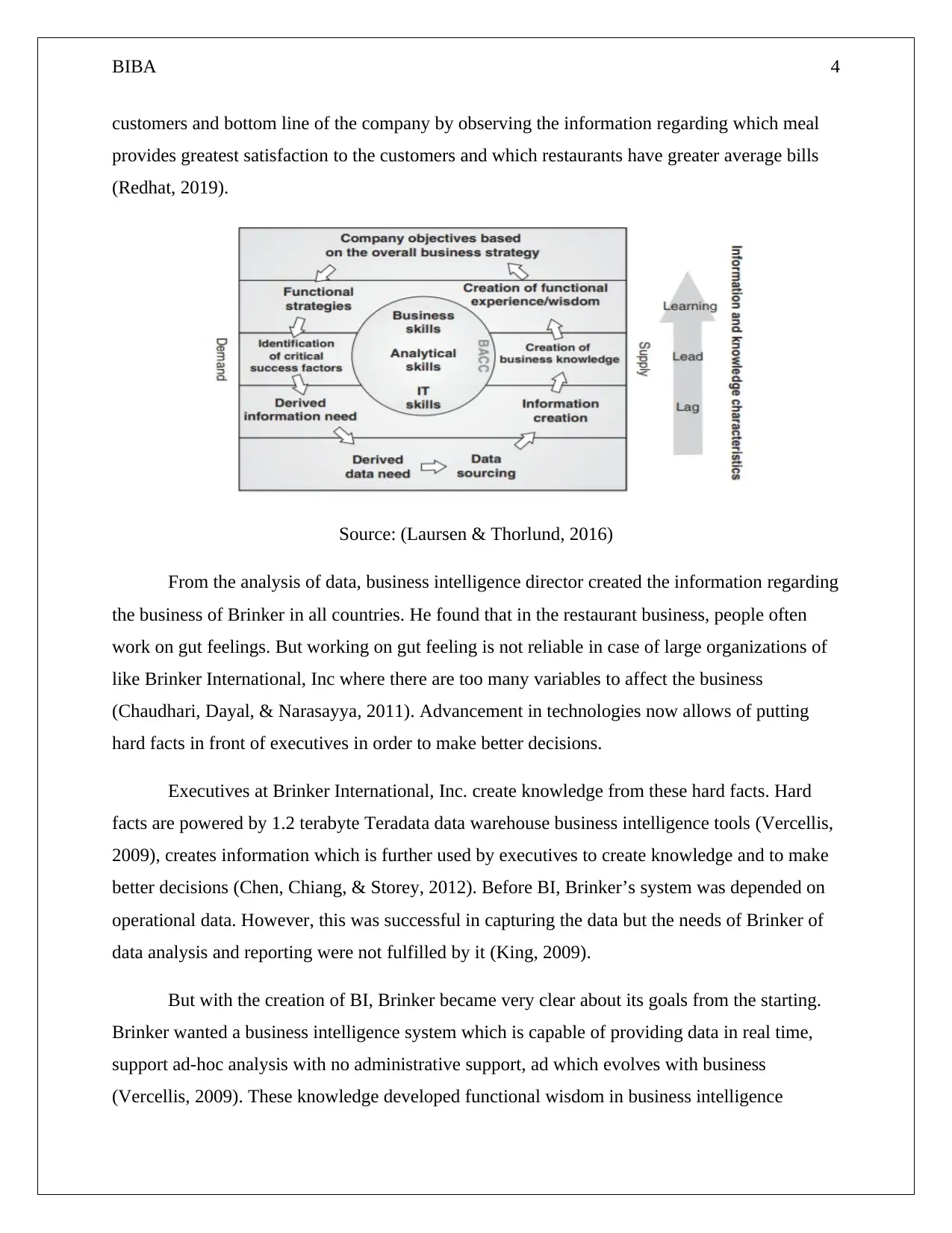
BIBA 4
customers and bottom line of the company by observing the information regarding which meal
provides greatest satisfaction to the customers and which restaurants have greater average bills
(Redhat, 2019).
Source: (Laursen & Thorlund, 2016)
From the analysis of data, business intelligence director created the information regarding
the business of Brinker in all countries. He found that in the restaurant business, people often
work on gut feelings. But working on gut feeling is not reliable in case of large organizations of
like Brinker International, Inc where there are too many variables to affect the business
(Chaudhari, Dayal, & Narasayya, 2011). Advancement in technologies now allows of putting
hard facts in front of executives in order to make better decisions.
Executives at Brinker International, Inc. create knowledge from these hard facts. Hard
facts are powered by 1.2 terabyte Teradata data warehouse business intelligence tools (Vercellis,
2009), creates information which is further used by executives to create knowledge and to make
better decisions (Chen, Chiang, & Storey, 2012). Before BI, Brinker’s system was depended on
operational data. However, this was successful in capturing the data but the needs of Brinker of
data analysis and reporting were not fulfilled by it (King, 2009).
But with the creation of BI, Brinker became very clear about its goals from the starting.
Brinker wanted a business intelligence system which is capable of providing data in real time,
support ad-hoc analysis with no administrative support, ad which evolves with business
(Vercellis, 2009). These knowledge developed functional wisdom in business intelligence
customers and bottom line of the company by observing the information regarding which meal
provides greatest satisfaction to the customers and which restaurants have greater average bills
(Redhat, 2019).
Source: (Laursen & Thorlund, 2016)
From the analysis of data, business intelligence director created the information regarding
the business of Brinker in all countries. He found that in the restaurant business, people often
work on gut feelings. But working on gut feeling is not reliable in case of large organizations of
like Brinker International, Inc where there are too many variables to affect the business
(Chaudhari, Dayal, & Narasayya, 2011). Advancement in technologies now allows of putting
hard facts in front of executives in order to make better decisions.
Executives at Brinker International, Inc. create knowledge from these hard facts. Hard
facts are powered by 1.2 terabyte Teradata data warehouse business intelligence tools (Vercellis,
2009), creates information which is further used by executives to create knowledge and to make
better decisions (Chen, Chiang, & Storey, 2012). Before BI, Brinker’s system was depended on
operational data. However, this was successful in capturing the data but the needs of Brinker of
data analysis and reporting were not fulfilled by it (King, 2009).
But with the creation of BI, Brinker became very clear about its goals from the starting.
Brinker wanted a business intelligence system which is capable of providing data in real time,
support ad-hoc analysis with no administrative support, ad which evolves with business
(Vercellis, 2009). These knowledge developed functional wisdom in business intelligence
Secure Best Marks with AI Grader
Need help grading? Try our AI Grader for instant feedback on your assignments.
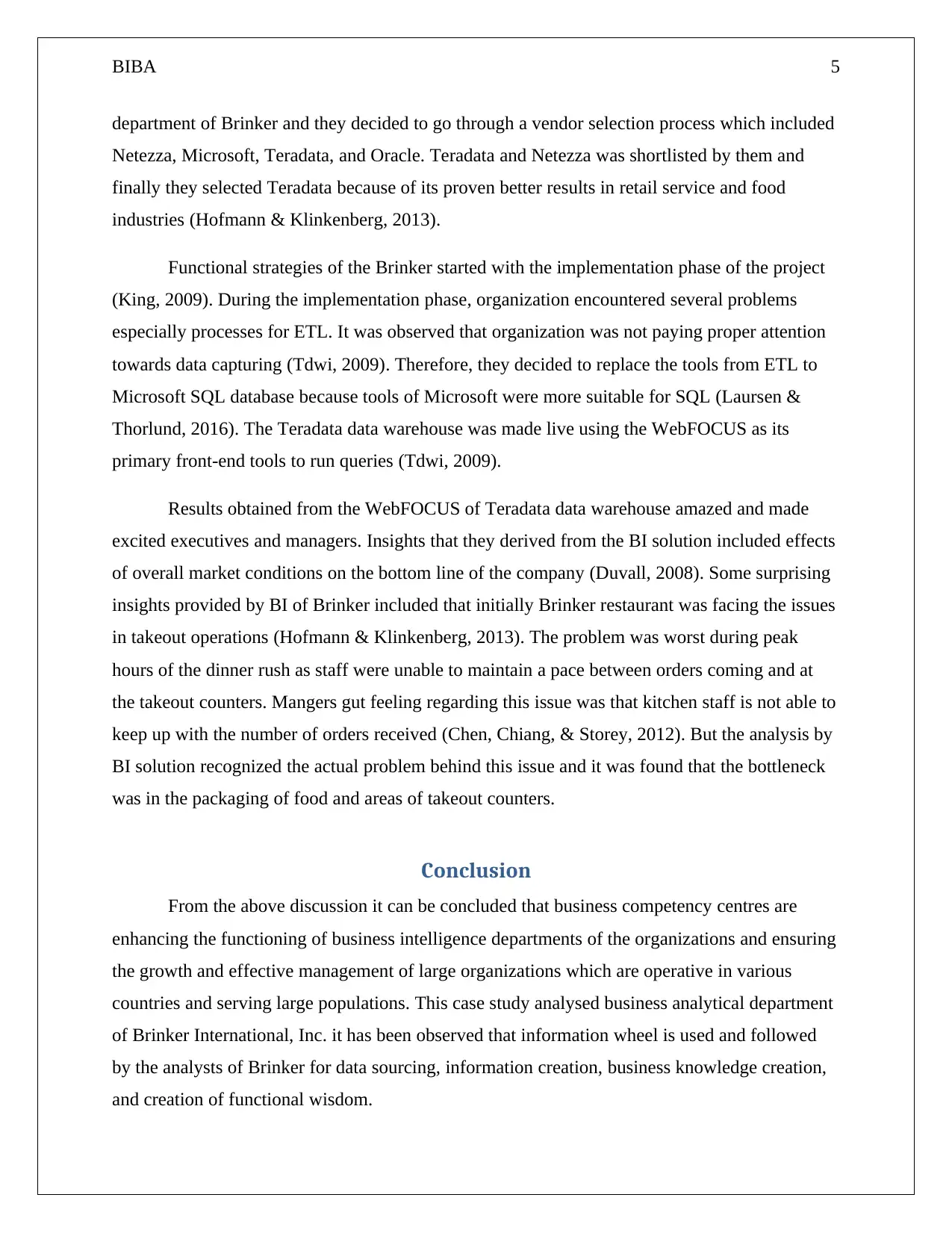
BIBA 5
department of Brinker and they decided to go through a vendor selection process which included
Netezza, Microsoft, Teradata, and Oracle. Teradata and Netezza was shortlisted by them and
finally they selected Teradata because of its proven better results in retail service and food
industries (Hofmann & Klinkenberg, 2013).
Functional strategies of the Brinker started with the implementation phase of the project
(King, 2009). During the implementation phase, organization encountered several problems
especially processes for ETL. It was observed that organization was not paying proper attention
towards data capturing (Tdwi, 2009). Therefore, they decided to replace the tools from ETL to
Microsoft SQL database because tools of Microsoft were more suitable for SQL (Laursen &
Thorlund, 2016). The Teradata data warehouse was made live using the WebFOCUS as its
primary front-end tools to run queries (Tdwi, 2009).
Results obtained from the WebFOCUS of Teradata data warehouse amazed and made
excited executives and managers. Insights that they derived from the BI solution included effects
of overall market conditions on the bottom line of the company (Duvall, 2008). Some surprising
insights provided by BI of Brinker included that initially Brinker restaurant was facing the issues
in takeout operations (Hofmann & Klinkenberg, 2013). The problem was worst during peak
hours of the dinner rush as staff were unable to maintain a pace between orders coming and at
the takeout counters. Mangers gut feeling regarding this issue was that kitchen staff is not able to
keep up with the number of orders received (Chen, Chiang, & Storey, 2012). But the analysis by
BI solution recognized the actual problem behind this issue and it was found that the bottleneck
was in the packaging of food and areas of takeout counters.
Conclusion
From the above discussion it can be concluded that business competency centres are
enhancing the functioning of business intelligence departments of the organizations and ensuring
the growth and effective management of large organizations which are operative in various
countries and serving large populations. This case study analysed business analytical department
of Brinker International, Inc. it has been observed that information wheel is used and followed
by the analysts of Brinker for data sourcing, information creation, business knowledge creation,
and creation of functional wisdom.
department of Brinker and they decided to go through a vendor selection process which included
Netezza, Microsoft, Teradata, and Oracle. Teradata and Netezza was shortlisted by them and
finally they selected Teradata because of its proven better results in retail service and food
industries (Hofmann & Klinkenberg, 2013).
Functional strategies of the Brinker started with the implementation phase of the project
(King, 2009). During the implementation phase, organization encountered several problems
especially processes for ETL. It was observed that organization was not paying proper attention
towards data capturing (Tdwi, 2009). Therefore, they decided to replace the tools from ETL to
Microsoft SQL database because tools of Microsoft were more suitable for SQL (Laursen &
Thorlund, 2016). The Teradata data warehouse was made live using the WebFOCUS as its
primary front-end tools to run queries (Tdwi, 2009).
Results obtained from the WebFOCUS of Teradata data warehouse amazed and made
excited executives and managers. Insights that they derived from the BI solution included effects
of overall market conditions on the bottom line of the company (Duvall, 2008). Some surprising
insights provided by BI of Brinker included that initially Brinker restaurant was facing the issues
in takeout operations (Hofmann & Klinkenberg, 2013). The problem was worst during peak
hours of the dinner rush as staff were unable to maintain a pace between orders coming and at
the takeout counters. Mangers gut feeling regarding this issue was that kitchen staff is not able to
keep up with the number of orders received (Chen, Chiang, & Storey, 2012). But the analysis by
BI solution recognized the actual problem behind this issue and it was found that the bottleneck
was in the packaging of food and areas of takeout counters.
Conclusion
From the above discussion it can be concluded that business competency centres are
enhancing the functioning of business intelligence departments of the organizations and ensuring
the growth and effective management of large organizations which are operative in various
countries and serving large populations. This case study analysed business analytical department
of Brinker International, Inc. it has been observed that information wheel is used and followed
by the analysts of Brinker for data sourcing, information creation, business knowledge creation,
and creation of functional wisdom.

BIBA 6
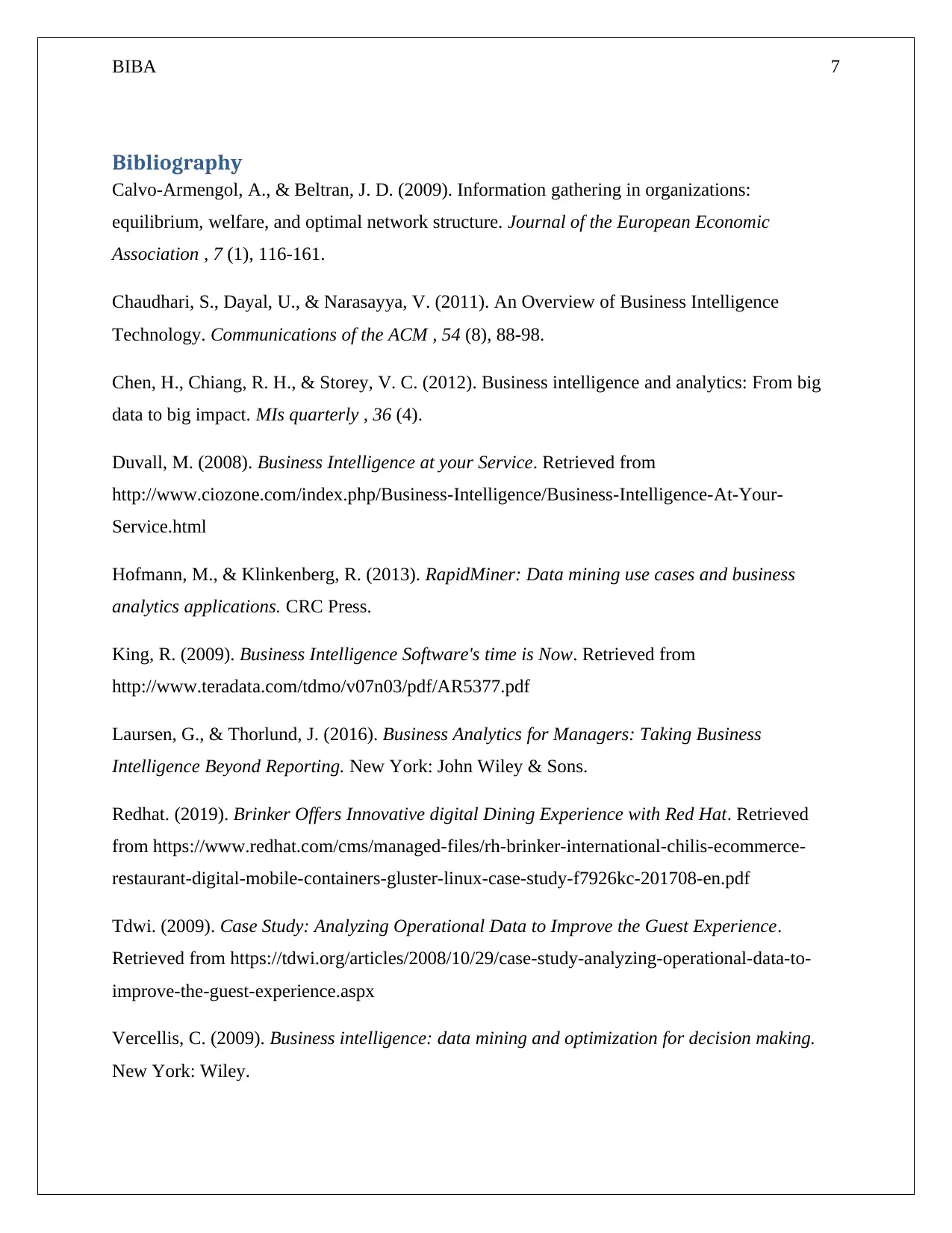
BIBA 7
Bibliography
Calvo-Armengol, A., & Beltran, J. D. (2009). Information gathering in organizations:
equilibrium, welfare, and optimal network structure. Journal of the European Economic
Association , 7 (1), 116-161.
Chaudhari, S., Dayal, U., & Narasayya, V. (2011). An Overview of Business Intelligence
Technology. Communications of the ACM , 54 (8), 88-98.
Chen, H., Chiang, R. H., & Storey, V. C. (2012). Business intelligence and analytics: From big
data to big impact. MIs quarterly , 36 (4).
Duvall, M. (2008). Business Intelligence at your Service. Retrieved from
http://www.ciozone.com/index.php/Business-Intelligence/Business-Intelligence-At-Your-
Service.html
Hofmann, M., & Klinkenberg, R. (2013). RapidMiner: Data mining use cases and business
analytics applications. CRC Press.
King, R. (2009). Business Intelligence Software's time is Now. Retrieved from
http://www.teradata.com/tdmo/v07n03/pdf/AR5377.pdf
Laursen, G., & Thorlund, J. (2016). Business Analytics for Managers: Taking Business
Intelligence Beyond Reporting. New York: John Wiley & Sons.
Redhat. (2019). Brinker Offers Innovative digital Dining Experience with Red Hat. Retrieved
from https://www.redhat.com/cms/managed-files/rh-brinker-international-chilis-ecommerce-
restaurant-digital-mobile-containers-gluster-linux-case-study-f7926kc-201708-en.pdf
Tdwi. (2009). Case Study: Analyzing Operational Data to Improve the Guest Experience.
Retrieved from https://tdwi.org/articles/2008/10/29/case-study-analyzing-operational-data-to-
improve-the-guest-experience.aspx
Vercellis, C. (2009). Business intelligence: data mining and optimization for decision making.
New York: Wiley.
Bibliography
Calvo-Armengol, A., & Beltran, J. D. (2009). Information gathering in organizations:
equilibrium, welfare, and optimal network structure. Journal of the European Economic
Association , 7 (1), 116-161.
Chaudhari, S., Dayal, U., & Narasayya, V. (2011). An Overview of Business Intelligence
Technology. Communications of the ACM , 54 (8), 88-98.
Chen, H., Chiang, R. H., & Storey, V. C. (2012). Business intelligence and analytics: From big
data to big impact. MIs quarterly , 36 (4).
Duvall, M. (2008). Business Intelligence at your Service. Retrieved from
http://www.ciozone.com/index.php/Business-Intelligence/Business-Intelligence-At-Your-
Service.html
Hofmann, M., & Klinkenberg, R. (2013). RapidMiner: Data mining use cases and business
analytics applications. CRC Press.
King, R. (2009). Business Intelligence Software's time is Now. Retrieved from
http://www.teradata.com/tdmo/v07n03/pdf/AR5377.pdf
Laursen, G., & Thorlund, J. (2016). Business Analytics for Managers: Taking Business
Intelligence Beyond Reporting. New York: John Wiley & Sons.
Redhat. (2019). Brinker Offers Innovative digital Dining Experience with Red Hat. Retrieved
from https://www.redhat.com/cms/managed-files/rh-brinker-international-chilis-ecommerce-
restaurant-digital-mobile-containers-gluster-linux-case-study-f7926kc-201708-en.pdf
Tdwi. (2009). Case Study: Analyzing Operational Data to Improve the Guest Experience.
Retrieved from https://tdwi.org/articles/2008/10/29/case-study-analyzing-operational-data-to-
improve-the-guest-experience.aspx
Vercellis, C. (2009). Business intelligence: data mining and optimization for decision making.
New York: Wiley.
Paraphrase This Document
Need a fresh take? Get an instant paraphrase of this document with our AI Paraphraser

BIBA 8
1 out of 8
Your All-in-One AI-Powered Toolkit for Academic Success.
+13062052269
info@desklib.com
Available 24*7 on WhatsApp / Email
![[object Object]](/_next/static/media/star-bottom.7253800d.svg)
Unlock your academic potential
© 2024 | Zucol Services PVT LTD | All rights reserved.